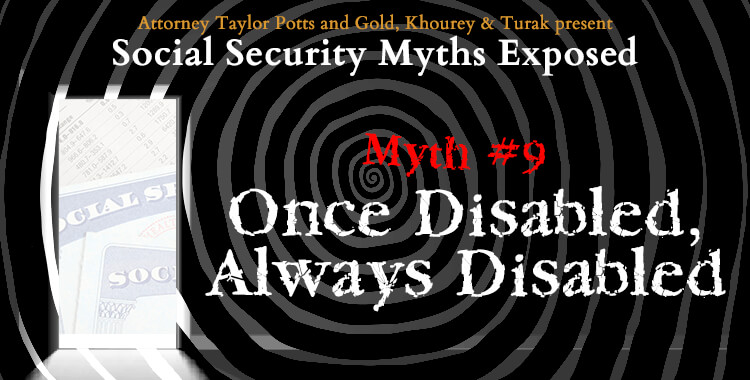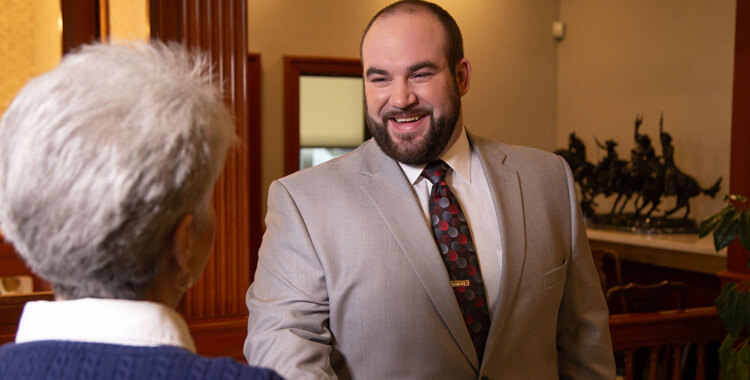
Every Tuesday, Social Security Disability Attorney Taylor Potts will expose some of the more frequent myths surrounding Social Security Benefits. Be sure to “like” our Facebook page and stop back each week as Attorney Potts takes you through The Twilight Zone – Social Security Style. If you have questions about Social Security Disability or VA Disability benefits, contact Attorney Taylor Potts at (304) 845-9750.
Social Security
You are about to enter a land beyond what many of us know. A land that could almost be considered a different dimension. A dimension of medical records, vocational classifications, administrative law judges, and functional limitations. Strap yourself in and get ready as we enter the twilight zone of Social Security Disability benefits. if you have questions, contact GKT and speak with a social security disability attorney at (304) 845-9750.
WARNING! PROCEED WITH CAUTION
Social Security Disability can be a strange and confusing land, but allow me to be your guide as we (hopefully) shed some of this mystery and bring it back into the realm of reality. In this series, we will take some of the most common (12 to be exact) misunderstandings, or myths, about Social Security Disability Insurance and Supplemental Security Income and help explain why these myths are not necessarily true and why the myths became so pervasive.
TOTALLY DISABLED, BUT NOT FOREVER
One of the questions I often get from people here in the Ohio Valley who are considering applying for Social Security Disability benefits is, “but what if I get a job offer I think I could perform, or what if my conditions improve and I want to go back to work?” Many people think once you are found to be disabled by the Social Security Administration that you are considered disabled for life. This is simply not true. Regardless of the benefit type you are receiving, whether it be Disability Insurance benefits, Supplemental Security Income, Survivors/Widow’s benefits, or any other disability benefit, you are not necessarily considered disabled for life.
ALL OR NOTHING!?
Part of the confusion is likely because Social Security Disability programs typically find individuals only totally and completely disabled, if they are disabled at all. This is in contrast to many other disability benefits people are accustomed to, such as Veteran’s disability benefits, private short and long term disability insurance, and Workers’ Compensation. All of these programs (generally) can find an individual partially disabled, and thus entitled to reduced payments in connection with that partial disability. This is not true for any Social Security Disability payments.

Under Social Security Disability benefits you are either totally and completely disabled and unable to work or you are not. Social Security, much like Yoda, states “do or do not, there is no try.” However, being completely disabled and unable to work does not mean you will always be so. Here the distinction to remember is one of severity vs. length.
SOCIAL SECURITY REVIEWS YOUR CONDITION
In fact, the Social Security Administration will review your continued entitlement at regular intervals to determine if you remain disabled under their rules. These reviews are unsurprisingly called Continuing Disability Reviews (CDRs). There are two different types of CDRs: 1) medical and 2) work. Work CDRs are fairly simple, the Social Security Administration reviews your earnings record to determine if you are working and, if you are working, if those work earnings exceed the allowable levels. Here, Social Security is looking at Substantial Gainful Activity.
More important than the work CDR is the medical CDR.
Under the medical CDR, the Social Security Administration will review everything, including any work, to determine if the medical conditions that gave rise to your disability have improved enough that you could return to work. If your condition has improved enough to return to work, the Social Security Administration will terminate your disability benefits. How often your claim gets medically reviewed depends on the severity of your condition and how likely your condition is to improve.
Your claim will be classified in one of three ways: 1) expected recovery, 2) possible recovery, and 3) recovery not expected. Under these classifications your claim will likely be reviewed with the following regularity:
- Expected recovery – your claim will likely be reviewed every six (6) to eighteen (18) months.
- Possible recovery – your claim will be reviewed around every three (3) years.
- Recovery unexpected – claims at this level will normally be reviewed no more than once every five (5) to seven (7) years.
Under these CDRs, you will be required to provide Social Security updated records and may be subjected to further examinations. If you do not comply with Social Security’s requests, they may terminate your benefits regardless of your work or medical status.
While these reviews can lead to a termination of benefits, it is important to remember that the most likely outcome is your condition has not changed and you remain entitled to benefits. Thus, a person can remain disabled indefinitely as long as their CDRs find them disabled. Do not fear, you can appeal any decision regarding changes to benefits under a CDR.
YOU ALWAYS HAVE A CHOICE!
The most important thing to remember is that you always have a choice. If you desire to return to work, you can always do so. There are several ways to accomplish a return to work.
The first is to return to work part-time below the significant gainful activity level (as of 2020, the level is $1,260.00 in earnings per month). Exactly how this income affects your Social Security disability monthly payments will depend on the type of benefit or benefits you receive, but staying below the SGA level will not terminate your entitlement to those benefits.

The second way to return to work is to engage with the Social Security Administration in one of their return to work programs, such as the Ticket to Work Program. These programs allow you to return to work, even at full-time levels, while still keeping certain benefits and assistance from the Social Security Administration. While they do not last forever, these programs are a great way to test returning to work, without risking possible negative consequences if it doesn’t work out.
Finally, you can simply return to work at any time and eventually your Social Security Disability benefits would cease because of this. If this is the route you take in returning to work, it is important that you notify the Social Security Administration that you will be returning to work and you desire to stop receiving benefits. If you do not inform Social Security and you continue to receive Social Security disability payments, you could be responsible to pay back any overpayments that occur once Social Security determines you are no longer eligible.
GKT Social Security Disability Attorney
Simply because you apply for benefits, are found disabled, and ultimately become entitled to Social Security Disability benefits does not mean that you are disabled for the rest of your life. You always have the ability to return to work either through a Social Security program or simply by your own decision.
All of this can be confusing. Gold, Khourey & Turak is a local social security law firm that can help you with your Social Security Disability benefits. From how to engage with Social Security when wanting to return to work to navigating a Continuing Disability Review, or even a termination based on a CDR, know that you are not alone.

We have experience in all areas of Social Security Disability law. GKT has assisted thousands of individuals throughout the Ohio Valley with their Social Security claims and, chances are, we can help you too. Contact our office at (304) 845-9750 for a free consultation. Home, weekend, and evening appointments are available. We look forward to speaking with you.


